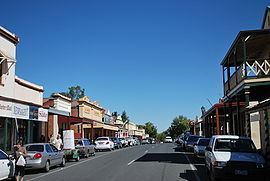Population 1,063 (2006 census) Postal code 3683 | Postcode(s) 3683 Local time Sunday 4:27 PM | |
 | ||
Weather 31°C, Wind S at 11 km/h, 30% Humidity Points of interest Chiltern-Mt Pilot National Park, Chiltern Box-Ironbark National Park, Honeyeater Picnic Area | ||
Chiltern is a town in Victoria, Australia, in the northeast of the state between Wangaratta and Wodonga, in the Shire of Indigo. At the 2006 census, Chiltern had a population of 1063. The town is close to the Chiltern-Mount Pilot National Park. Chiltern was once on the main road between Melbourne and Sydney but is now bypassed by the Hume Freeway running one kilometre to the east.
Contents
Map of Chiltern VIC 3683, Australia
History
The area of Chiltern was on the Wahgunyah cattle run and was known as Black Dog Creek. The township, named after the Chiltern Hills in England, was surveyed in 1853 but not established until gold discoveries in 1858-59 during the greater Victorian Gold Rush period. The Post Office opened on 1 September 1859.
Many of Chiltern's buildings are classified by the National Trust. In 1859, many shop-keepers and miners from around Beechworth and the Ovens Valley districts followed the rush and re-located into Chiltern.
The Grape Vine Hotel, on the corners of Main Street and Conness Street, boasts the largest grapevine in Australia, planted in 1867.
Gold
The discovery of gold in late 1858 and early 1859, brought a huge shift in population into the Chiltern - Black Dog Creek area. Gold discoveries drew many miners away from the nearby Ovens goldfields; namely Beechworth, Nine Mile Creek and Stanley during the big drought of 1859. Unlike those surfaced based sluicing mining operations around Beechworth, the gold around Chiltern was extracted by sinking deep wet leads. These operations required a different type of miner and working groups, capable of sinking shafts to some 400 feet in depth. Miners with these skills and abilities came into the area, from Ballarat and Bendigo and joined with the sluicers from around Beechworth and the Ovens. Miners from the Ballarat goldfields were considered 'radical', because of their connections with the Eureka Rebellion (1854). Some of these miners were colourful characters and the most notable, a colourful and radical A.A. O'Connor, stood for parliament in 1859 as the would-be member for the Ovens; his escapades and the social tensions his candidature aroused appear in O'Brien's book which is cited below.
While Beechworth's gold production declined during 1859, due in part to the drought and lack of water for sluicing, Chiltern's gold production increased (O'Brien), to such an extend that Chiltern looked as if it would usurp the importance of Beechworth. Beechworth was the most important regional centre in North-eastern Victoria during the gold boom 1852–1859. Chiltern did overshadow Beechworth within a few years, especially when the main Melbourne-Albury rail by-passed Beechworth. Finally, when the gold dwindled during the early 1900s, so did Chiltern.
The town today
The town hosts an antique fair in August and an art show in October. The Chiltern-Mount Pilot National Park lies close to the town.
Chiltern has an Australian Rules football team competing in the Tallangatta & District Football League.
Golfers play at the Chiltern Golf Club on Howlong Road.
The winning clip of the 2009 J Award for Best Music Video of the Year, Alex Roberts' video for Art vs. Science's Parlez-vous Français?, was entirely shot in this town.
Several movies have been shot using Chiltern's well-preserved Victorian-era streetscapes, including Walt Disney's 'Ride a Wild Pony'.
Transport
The railway station is serviced by V/Line services running between Melbourne and Albury.
